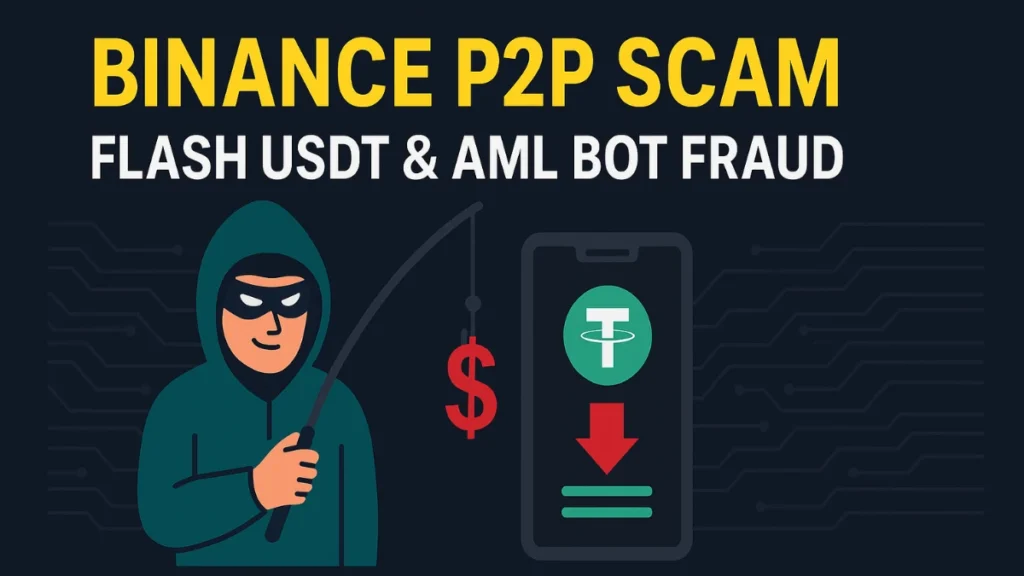Cryptocurrency may offer financial freedom, but it also opens the door to sophisticated scams targeting unaware investors. One of the fastest-growing and most devastating scams affecting users—especially on platforms like Binance P2P—involves fake “Flash USDT” and “AML Verification” checks. These scams have led many losing thousands of dollars within minutes, all due to online tricks, phishing sites, and wallet-draining smart contracts.

In this article, we’ll walk through how these scams work, share lessons from real case patterns, and explain how to avoid falling for them.
What Is the Flash USDT / AML Verification Scam?
The scam typically starts when a user wants to sell their USDT (Tether) on Binance P2P. A scammer contacts them—often over WhatsApp or Telegram—pretending to be a legitimate buyer. Then comes the trap:
- They claim the seller must verify whether their USDT is “flash USDT” (a completely fabricated concept).
- They share a link to a website like
usdtcheck.netor something similar. - The site pretends to be a “fund verification tool” or “AML bot” and asks the user to connect their crypto wallet or enter their passkey.
Once the user connects their wallet or enters their private key or seed phrase, the scammer either gains direct access to the wallet or executes a rogue smart contract that drains all funds.
A Real Case: 4,678 USDT Gone in Seconds
A user recently reported on reddit, losing over 4,600 USDT in a Binance P2P scam. Here’s how the scam unfolded:
- The victim posted their WhatsApp number while listing USDT for sale on Binance P2P.
- The scammer called and asked them to confirm that their funds weren’t “flash USDT.”
- The victim followed instructions to send 10 USDT to a Binance wallet, then opened
usdtcheck.netvia the Discover tab in the Binance app. - The phishing site asked them to enter their passkey.
- Moments later, all of their 4,678 USDT disappeared. The transaction was recorded on the blockchain via a smart contract.
This story mirrors hundreds of similar experiences shared by users across crypto communities.
How the Scam Works Technically
- Phishing Site: A fake domain mimicking legit services tricks users into sharing wallet details or signing transactions.
- Unlimited Token Approval: If the user connects a wallet, the phishing site prompts a transaction that grants the scammer’s smart contract unlimited USDT spend permission.
- Smart Contract Drain: The scammer uses minimal BNB (preloaded) to execute a token transfer contract, draining the wallet.
- Rapid Laundering: Funds are quickly bridged to other chains, mixed, or sent to centralized exchanges to disappear.
Common Mistakes That Victims Make
- Sharing phone numbers on Binance P2P listings.
- Trusting strangers who ask to “verify” crypto assets.
- Visiting phishing sites or typing seed phrases into unknown websites.
- Not understanding what a smart contract is or what a wallet approval does.
Why These Scams Work
Scammers prey on emotions—urgency, trust, fear of missing out, or compliance with authority. Many investors, especially new ones, fall victim when social conversations escalate into action requests like wallet connections or fund verification.
Based on common scam reports and behavioral patterns:
- Losses often range from hundreds to tens of thousands of dollars.
- Many scams involve either fake verification sites or spoofed smart contract approvals.
- Victims often realize their mistake only after the transaction is confirmed and irreversible.
Real Victim: What People Experienced in Crypto Scams
Understanding victim experiences helps identify the red flags before it’s too late. In various crypto forums, users have described heartbreaking losses:
- One investor lost $10,000 after connecting their wallet to a fake verification site promoted by a scammer.
- Another lost over 2.5 lakh INR by clicking a phishing link disguised as a DEX.
- Several victims admitted they quit crypto entirely after losing their savings.
These stories highlight how scammers exploit trust and technical ignorance. The sequence is always similar: a social interaction (via Telegram, WhatsApp, or P2P chat), a request to verify tokens or test transfers, a phishing link, and ultimately a wallet drain via smart contract.
The emotional and financial toll is severe, but recognizing the pattern can help prevent future incidents.
Expert Advice to Protect Your Wallet
DO:
- Use official platforms like Binance, CoinDCX, or WazirX directly.
- Confirm URLs (e.g.,
binance.com,etherscan.io) before signing or connecting. - Revoke token allowances regularly using tools like
revoke.cashorbscscan.com/tokenapprovalchecker. - Keep your seed phrase offline and private—never share it digitally.
DON’T:
- Don’t post personal contact details (WhatsApp/Telegram) on public P2P listings.
- Don’t trust unsolicited calls or messages asking to verify tokens.
- Don’t click on links for “fund verification” or “AML bots.”
- Don’t enter passkeys, wallet passwords, or seed phrases on websites—only within your trusted wallet app.
What to Do If You’ve Been Scammed
If you already fell victim:
- Lodge a Cyber Crime FIR immediately with wallet address and transaction ID.
- Report wallet address on platforms like
scam-alert.ioand block explorers. - Contact Binance or relevant exchange support to freeze wallets if funds reach KYC’d accounts.
- Inform Telegram/WhatsApp groups to prevent others from falling into the same trap.
Conclusion: Crypto Is Powerful, But So Are Scammers
Scammers prey on the uninformed. The decentralized nature of crypto, while empowering, also means there are no safety nets if you hand over your keys, approvals, or passwords. Always double-check before clicking, connecting, or typing anything. And remember—flash USDT isn’t real, but your money is.
Read More

